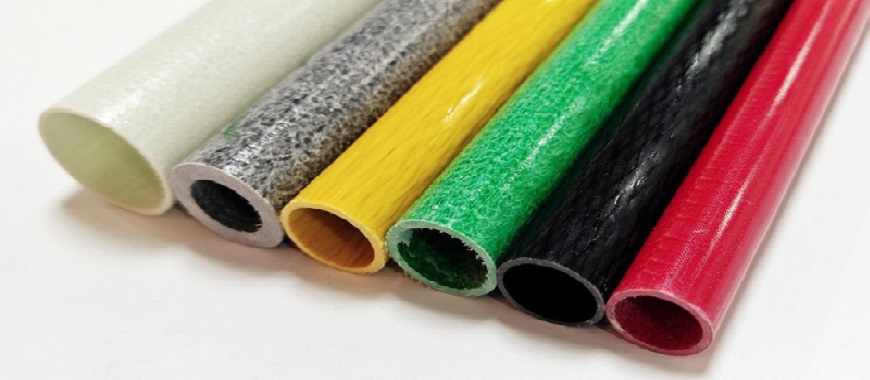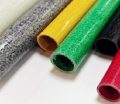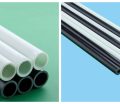
Thin fiberglass tubes are lightweight yet durable materials widely used across various industries. These tubes offer strength and flexibility, making them ideal for custom manufacturing and structural applications. Thin fiberglass tubes are often chosen when projects require non-metallic solutions that are easy to shape and resistant to environmental damage. In many cases, thin fiberglass tubes are preferred over other materials for tasks where reduced weight plays a critical role, such as aerospace components or lightweight frameworks. Their high strength-to-weight ratio makes them essential in situations that demand robust yet lightweight performance. Thin fiberglass tubes are also corrosion-resistant, contributing to long-lasting functionality in outdoor and marine environments. Different from fiberglass squate tubes, which are typically used for applications requiring more rigidity and stability, thin fiberglass tubes excel in projects where flexibility and a high strength-to-weight ratio are crucial.
Advantages of Thin Fiberglass Tubes
Thin fiberglass tubes provide significant benefits across multiple industries due to their lightweight properties, durability, and versatility. Below are five key aspects where thin fiberglass tubes excel:
- Lightweight Strength: Despite being lightweight, these tubes offer high tensile strength, making them reliable in structural frameworks and load-bearing applications.
- Corrosion Resistance: Thin fiberglass tubes resist rust and degradation, making them ideal for marine, outdoor, or humid environments.
- Thermal Stability: Fiberglass tubes withstand high temperatures, providing stability in industrial settings without warping or weakening.
- Customization Options: These tubes can be tailored in size, shape, and thickness to meet specific project requirements.
- Cost-Effectiveness: Compared to materials like carbon fiber, thin fiberglass tubes offer a budget-friendly solution without compromising performance.
RF Transparency in Thin Fiberglass Tubes
Thin fiberglass tubes are known for their ability to allow radio waves to pass through without interference. This RF transparency makes them valuable in telecommunications, defense, and electronics industries.
How Thin Fiberglass Tubes Allow Radio Waves to Pass Through
- Fiberglass does not contain metallic components, ensuring no disruption to electromagnetic signals.
- RF signals move freely through these tubes, reducing signal loss or interference.
- The seamless transmission of radio waves improves the reliability of communication equipment.
Applications Where RF Transparency Is Crucial
- Telecommunication Equipment: Antennas and communication devices use thin fiberglass tubes as protective housings to ensure unblocked signal flow.
- Drones and UAVs: Signal-carrying components are enclosed in fiberglass tubes to maintain control and communication with ground stations.
- Radar Systems: Radar installations use fiberglass to protect sensitive components without obstructing signal performance.
- Medical Imaging Devices: Fiberglass tubes help ensure RF transparency in devices such as MRI scanners, where electromagnetic waves are essential for imaging.
Non-Conductivity of Thin Fiberglass Tubes
The non-conductive nature of thin fiberglass tubes makes them ideal in electrical and high-voltage environments. Their insulating properties prevent electrical currents from flowing through the material, providing enhanced safety in industrial applications.
Insulating Properties of Thin Fiberglass Tubes
- Fiberglass is a natural electrical insulator, reducing the risk of short circuits or electrocution.
- These tubes remain stable under exposure to high voltage, preventing arcing and electrical failures.
- Unlike metal alternatives, thin fiberglass tubes resist electromagnetic interference, maintaining signal clarity in electrical systems.
Use-Cases Requiring Electrical Insulation
- High-Voltage Power Systems: Thin fiberglass tubes are used to insulate wiring and other components in high-voltage environments.
- Transformer and Substation Equipment: The non-conductive properties ensure safe housing for electrical parts in substations.
- Electronic Enclosures: These tubes protect sensitive circuits and wiring from accidental contact with other electrical parts.
- Industrial Robotics: Fiberglass tubes provide safe enclosures for electrical wiring, preventing contact with metal components.
- Construction of Safety Tools: Insulating tools, such as ladders used near power lines, often incorporate fiberglass tubes to prevent electrical conduction.
The combination of RF transparency and non-conductivity in thin fiberglass tubes highlights their unique versatility. Their ability to perform efficiently in specialized environments, such as high-voltage systems and communication networks, makes them essential for modern applications. These advantages ensure thin fiberglass tubes remain a preferred choice for industries that demand durability, safety, and efficiency.
Key Benefits of Installing Fiberglass Fuse Tube Products
Thin Fiberglass Tubes for Sale and Price Considerations
Thin fiberglass tubes are widely available in markets that cater to industrial, construction, and engineering applications. Their affordability, versatility, and durability make them an attractive option across different sectors. However, prices can vary based on several key factors.
Market Overview for Thin Fiberglass Tubes
- Standard Price Ranges:
The typical price range for thin fiberglass tubes varies from $5 to $50 per tube, depending on size and customization. Bulk orders tend to receive discounts, making large-scale purchases more economical. - Material Costs:
The quality of the fiberglass material influences pricing. Tubes with higher tensile strength or advanced coatings are generally more expensive. - Production Processes:
Tubes made through filament winding are often costlier due to their superior strength, while pultruded tubes are more affordable. - Customization Options:
Custom sizing or special finishes, such as UV protection, can increase the price of thin fiberglass tubes. - Logistics and Shipping Costs:
Prices may include transportation fees, particularly for bulk orders or international shipments, impacting the total purchase cost.
Finding Thin Fiberglass Tubes Near Me or Nearby
At GangLong Fiberglass, we understand the importance of finding reliable suppliers for thin fiberglass tubes nearby. Sourcing locally provides several advantages, including faster delivery and easier communication with vendors. Below are some tips to help locate suppliers and distributors near you.
Tips for Locating Local Suppliers or Distributors
- Search Online Marketplaces:
Local directories and industrial supply websites can offer comprehensive lists of fiberglass tube providers in your area. - Check with Industrial Equipment Stores:
Many hardware stores or industrial supply shops keep fiberglass tubing in stock, especially for electrical or construction purposes. - Visit Trade Fairs and Industry Events:
Participating in trade shows provides opportunities to connect with suppliers offering fiberglass tubes and other materials locally. - Ask for Referrals:
Reaching out to contractors or engineers can help identify trusted distributors of fiberglass products in your area.
Advantages of Purchasing Thin Fiberglass Tubes from Nearby Sources
- Reduced Shipping Costs:
Local purchases eliminate the need for long-distance shipping, lowering transportation fees and making the purchase more affordable. - Faster Delivery Times:
Nearby suppliers can deliver thin fiberglass tubes quickly, ensuring projects stay on schedule. - Improved Customer Support:
In-person communication with local suppliers allows for better product guidance, troubleshooting, and customized service. - Support for Local Businesses:
Buying from nearby vendors helps support the local economy and fosters sustainable relationships with regional suppliers.
Purchasing thin fiberglass tubes from local sources brings convenience, cost savings, and reliable service. At GangLong Fiberglass, we take pride in assisting customers with personalized service and expert advice, ensuring the right fiberglass tube solutions for every project.
Durable Fiberglass Fluted Tube in Architectural Design Projects
Exploring 3″ Thin Fiberglass Tubes and Other Sizes
Thin fiberglass tubes come in various sizes, each offering distinct advantages for different applications. Among these, 3″ fiberglass tubes stand out for their specific uses, but understanding other size options is equally important for selecting the right product. Below, we explore the features and applications of 3″ fiberglass tubes, followed by a discussion on how other size variations influence performance.
3″ Fiberglass Tubes and Their Applications
3″ fiberglass tubes are popular for projects that require a balance between strength and lightweight properties. Their diameter allows them to handle moderate structural loads while remaining easy to install. The following use-cases highlight the versatility of these tubes:
- Industrial Support Structures:
3″ fiberglass tubes provide essential support in industrial frameworks, including racks, braces, and ladders. They offer corrosion resistance, making them ideal for outdoor use. - Electrical Conduit Systems:
These tubes are often used to encase electrical wiring in environments where non-conductive materials are needed to ensure safety. - Marine Applications:
In the marine industry, 3″ fiberglass tubes function as components for handrails, ladders, and protective enclosures due to their resistance to saltwater. - Sports Equipment and Poles:
Their lightweight and durable nature makes them suitable for poles used in sports equipment, such as vaulting poles or flagpoles. - Pipeline Reinforcement:
3″ fiberglass tubes are used as sleeves to reinforce pipelines, providing protection from corrosion and environmental stress.
Size Variations of Thin Fiberglass Tubes and Their Impact
Thin fiberglass tubes are available in a variety of sizes to suit specific needs. Each diameter brings unique strengths and challenges, and selecting the right size is essential for achieving the best results.
- Small-Diameter Tubes (Below 1″)
These tubes are highly flexible and lightweight, making them ideal for intricate projects, such as aerospace components or precision instruments. However, they are less suited for load-bearing tasks. - Mid-Range Tubes (1″ to 2″)
Tubes in this size range provide a good balance between strength and flexibility. They are often used in construction frameworks and light-duty support structures. - 3″ Fiberglass Tubes
As discussed, 3″ fiberglass tubes strike a balance between structural performance and ease of handling, making them useful across multiple industries. - Large-Diameter Tubes (Above 4″)
These tubes are a specialized type of large fiberglass tubes, offer excellent strength and rigidity, suitable for heavy-duty applications. However, they are less portable and may require specialized installation. - Custom Sizes
Custom-sized thin fiberglass tubes are available for specific projects, ensuring that unique design requirements are met. However, customization can increase the overall cost and lead times.
Choosing the appropriate size for thin fiberglass tubes ensures optimal performance and longevity. Smaller tubes offer flexibility, while larger ones provide enhanced strength. Understanding the strengths and applications of 3″ fiberglass tubes, along with other size options, allows users to make informed decisions based on their project needs.
Where to Buy Thin Fiberglass Tubes Near Me
At GangLong Fiberglass, we understand the importance of finding thin fiberglass tubes conveniently and efficiently. Whether you need these tubes for structural projects, electrical insulation, or industrial applications, local sourcing provides significant benefits. Below, we discuss various options for purchasing thin fiberglass tubes through nearby channels and the key factors to consider when evaluating suppliers.
Options for Sourcing Thin Fiberglass Tubes Through Local Channels
- Industrial Supply Stores
Many hardware and industrial equipment stores carry fiberglass tubes, including thin fiberglass tubes in various sizes. Visiting these stores allows for hands-on inspection of products and immediate purchase without waiting for shipping. - Local Distributors and Wholesalers
Reaching out to fiberglass material distributors in your area can provide access to a wider selection. These distributors often carry bulk supplies, making them a practical choice for large projects. - Trade Fairs and Industry Events
Attending local trade fairs is an excellent way to connect with manufacturers and distributors offering thin fiberglass tubes. These events also provide opportunities to discuss your project requirements in detail with vendors. - Direct Manufacturer Contact
In some cases, manufacturers may offer direct sales to customers. At GangLong Fiberglass, we provide guidance and support, ensuring that our clients receive the right products based on their unique project needs. - Local Contractors and Installers
Contractors specializing in industrial and construction projects often have access to fiberglass tubes through their supplier networks. Partnering with them can simplify procurement and ensure high-quality materials.
Important Considerations When Comparing Nearby Suppliers and Their Offerings
- Availability and Stock Levels
Ensuring the availability of thin fiberglass tubes in required sizes and quantities is essential. Suppliers with consistent stock reduce the risk of project delays. - Product Quality and Certification
Evaluating the quality of thin fiberglass tubes is critical. Look for certifications that verify strength, durability, and material performance, especially for demanding environments. - Pricing and Discounts
Pricing can vary between suppliers, so comparing costs across different vendors is recommended. Some suppliers offer bulk discounts, making large orders more cost-effective. - Customer Service and Technical Support
Suppliers who provide responsive customer service and technical support make a difference, especially when specific product recommendations or troubleshooting is needed. - Delivery and Pickup Options
Convenient delivery services or in-store pickup options contribute to smoother procurement. Suppliers with flexible delivery schedules can meet tight project timelines.
At GangLong Fiberglass, we prioritize customer satisfaction and aim to make the procurement of thin fiberglass tubes as seamless as possible. By sourcing locally, you can reduce shipping times and costs, ensuring that your projects stay on schedule. Our team is committed to offering expert advice, helping you find the perfect fiberglass tube solutions near you.
High-Performance Fiberglass Filament Tube for Industrial Projects
Why Choose Thin Fiberglass Tubes
Thin fiberglass tubes offer a unique combination of strength, flexibility, and lightweight properties, making them indispensable across various industries. Their versatility enables their use in fields ranging from aerospace to marine applications, ensuring optimal performance where non-conductive or corrosion-resistant materials are required.
Key Takeaways on Thin Fiberglass Tubes
- Versatile Applications: Thin fiberglass tubes are essential for electrical insulation, structural reinforcement, and RF-transparent systems in telecommunications.
- Multiple Sizes and Custom Options: Tubes come in a variety of sizes, such as 3″ fiberglass tubes, which balance durability and ease of use.
- Performance in Harsh Conditions: These tubes resist corrosion and high temperatures, making them ideal for outdoor, marine, and industrial environments.
- Cost-Effectiveness and Local Availability: Sourcing thin fiberglass tubes from local suppliers reduces transportation costs and delivery times, helping projects stay on budget and schedule.
- Safety Advantages: Their non-conductive nature ensures safe use in electrical systems, preventing accidents in high-voltage applications.
Importance of Choosing the Right Thin Fiberglass Tubes for Your Application
Selecting the correct type and size of thin fiberglass tubes ensures project success by matching material properties to the intended use. Each application may require different sizes, finishes, or strength levels, so understanding the demands of the project is crucial.
- Structural Projects: Larger tubes provide greater load-bearing capacity, while smaller tubes offer flexibility for delicate or intricate frameworks.
- Electrical Systems: Non-conductive tubes are critical for safety in power stations and industrial robotics.
- Telecommunications Applications: RF transparency ensures uninterrupted signal transmission, especially in antenna housings and radar systems.
- Marine Use: Corrosion resistance makes thin fiberglass tubes ideal for shipbuilding and offshore structures.
Choosing the right thin fiberglass tubes not only enhances performance but also ensures durability and safety in the long term. Matching specific project requirements with the correct tube type helps minimize costs and maximize efficiency. With the right selection, these tubes can offer reliable solutions for years to come, making them a valuable asset across multiple industries.
FAQs about Thin Fiberglass Tubes
Fiberglass tubes are used across various industries due to their strength, durability, and lightweight properties. These tubes are ideal for applications where non-metallic materials are required. In the marine industry, fiberglass tubes are often used for ladders, handrails, and protective enclosures because of their corrosion resistance. Electrical systems also benefit from fiberglass tubes since their non-conductive nature provides essential insulation in high-voltage environments. In construction, fiberglass tubes function as structural reinforcements and are used in framing, bridges, and roofing applications. Additionally, the telecommunications industry uses them to house antennas and equipment where RF transparency is necessary to prevent signal interference. Their versatility makes them suitable for recreational equipment, including tent poles, fishing rods, and flagpoles, where lightweight strength is critical.
FRP (Fiberglass Reinforced Plastic) tubes are available in a variety of sizes to suit different project needs. Standard sizes can range from small diameters, such as 0.5 inches, to larger ones exceeding 4 inches. Commonly, a 3-inch diameter tube is used for structural support and outdoor installations due to its balance of strength and weight. Lengths also vary, with standard options ranging from a few feet to 12 feet or more. Wall thicknesses differ as well, typically between 1/8 inch to 1/2 inch, depending on the required strength and application. Custom sizes are often available from manufacturers for specialized applications, providing flexibility to meet unique project requirements. Choosing the correct size ensures that the fiberglass tube fits its intended purpose while maintaining performance and durability.
Cutting fiberglass tubes requires specific tools and techniques to ensure clean cuts without causing damage. The most effective tools include a fine-toothed hacksaw, a diamond-coated blade, or an abrasive wheel. To begin, it is recommended to mark the cutting line with tape to prevent the fiberglass from splintering. Wearing safety goggles, gloves, and a dust mask is essential, as fiberglass dust can cause skin irritation and respiratory issues. Gentle pressure should be applied while cutting to avoid cracking the material. Once the cut is complete, sanding the edges with fine-grit sandpaper smooths out any rough surfaces and minimizes splinter risks. Using these proper tools and safety practices ensures precise cuts and maintains the tube’s integrity.
The compressive strength of fiberglass tubes varies based on factors such as size, thickness, and the type of fiberglass used. On average, fiberglass tubes can withstand compressive forces between 30,000 to 40,000 psi. Thicker tubes generally offer higher compressive strength, making them suitable for load-bearing applications. Filament-wound fiberglass tubes often provide superior compressive strength compared to pultruded tubes due to their reinforced structure. Environmental factors, such as exposure to high temperatures and humidity, may slightly reduce compressive performance over time. However, fiberglass remains resilient under most conditions, retaining its shape and strength for years. Understanding the compressive strength helps ensure the right tube is chosen for demanding applications, such as structural frameworks and heavy-duty supports.

As the editor of GangLong Fiberglass, I have years of experience and in-depth research, focusing on cable tray products, fiberglass solutions, and grille systems. I incorporate years of industry insights and practical experience into every content, committed to promoting the progress of the industry. At GangLong Fiberglass, my commitment is reflected in every product, from innovative cable trays to durable fiberglass solutions and sturdy grille systems. As an authoritative voice in the industry, my goal is to provide valuable information to professionals and businesses and promote forward-looking solutions.


